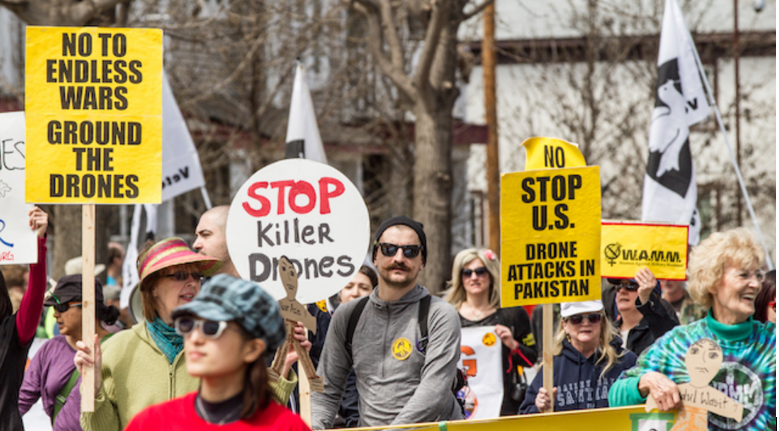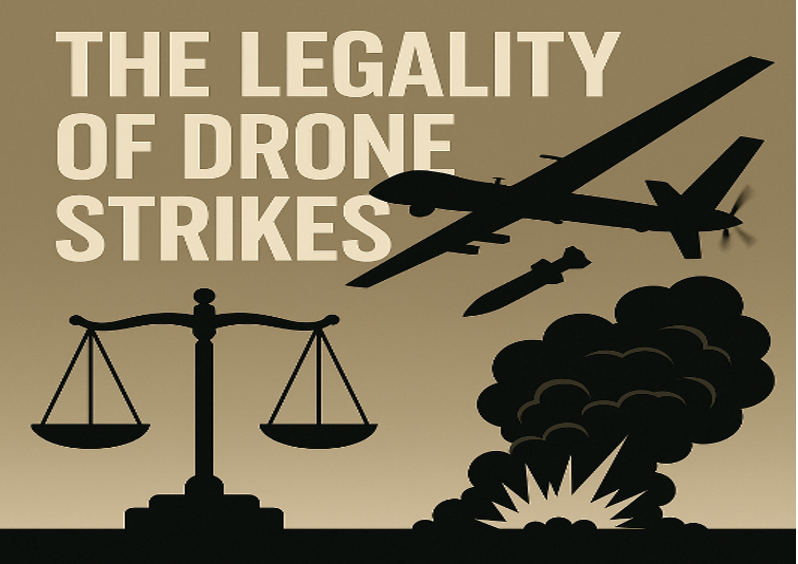Introduction
In an era where the pursuit of justice is considered a cornerstone for sustainable peace, the legality of drone strikes has emerged as a contentious global issue. The use of drones in military action has created new conversations around international law and human rights and raising important ethical questions about targeted killings. Drone strikes are an important dilemma as we wrestle to balance a need for national security with the foundational norms of accountability and justice.
Drone strikes involve the use of unmanned aerial vehicles (UAVs), more commonly called drones, to quickly execute a military strike. Drones can better be thought of as “slave aircraft,” where they are guided, or operated, by a person somewhere on the surface of the earth, making the UAV a remotely piloted vehicle instead of an autonomous. Drones from the military are generally weapons platforms with the most common being armed with missiles or bombs, but they can also be a form of harassment monitoring.
Drones stand out due to convenience and efficiency and are often the weapon of choice to target a person, vehicle, or building. Drone strikes have become increasingly routine with the United States conducting hundreds of drone attacks in Pakistan, Yemen, and Somalia, as well as other nations who also used the drone for military action.
Justice and peace
Fiat iustitia, pereat mundus, is a Latin maxim that means “Let justice be done, though the world may perish.” It is a powerful statement about the importance of justice, even if it means making difficult choices or facing negative consequences. The argument for whether peace or justice should be prioritized in the case of drone strikes is a contentious and complicated one. Proponents of peace tend to argue that seeking justice and accountability may actually cause more wars, as well as contribute to more violence and unrest. On the other hand, those who support justice and accountability argue that durable peace cannot be ensured without looking at the legal and ethical implications of drone strikes.
Supporters of the peace-first approach might point to the pragmatic consequences of prioritizing peace. They may suggest that in certain circumstances; the use of targeted drone strikes could avert greater conflicts and fatalities. Legally, they could invoke the principle of proportionality, saying that the net humanitarian advantage of avoiding a larger conflict outweighs the civilian harm of drone strikes.
On the other hand, proponents of justice and accountability emphasize the importance of upholding international law and human rights standards. They may use legal principles like the principle of distinction, which mandates that parties to a conflict differentiate between civilian and military objects. On this ground, they would argue that the neglect of justice and accountability weakens the rule of law, providing risky precedents for future military interventions. They may also invoke legal instruments such as the Geneva Conventions, which define the commitments of belligerents in war situations, including that of safeguarding civilians.
Legality of drone strikes:
The legality of drone strikes under international law is a complex and controversial issue. There is no specific treaty or convention that specifically addresses the legality of drone strikes. Consequently, the legality of drone strikes is determined based on current international law, including international humanitarian law (IHL) and international human rights law (IHRL), as well as national law.
According to IHL, belligerents are obligated to differentiate between combatants and civilians and take all practicable measures to reduce the harm to civilians. Drone strikes may be problematic under IHL if they cannot discriminate between combatants and civilians or if they produce unnecessary collateral harm.
Under IHRL, states are not allowed to arbitrarily or unlawfully deprive individuals of their lives. Drone strikes may engage IHRL concerns if they lead to the arbitrary or unlawful deprivation of life, or if they are employed in targeting individuals or groups of individuals for absence of due process of law.
The domestic legality of drone strikes differs according to country. In the United States, for instance, the Obama administration claimed that drone attacks were constitutional under the Authorization for Use of Military Force (AUMF) that had been enacted by Congress after the September 11 attacks. Yet, legal scholars have countered that the AUMF does not have the authority to employ drone attacks on targets who are not presenting an imminent threat to the United States.
Case Study: The Anwar al-Awlaki Drone Strike
In 2011, the U.S. conducted a drone strike in Yemen that resulted in the death of Anwar al-Awlaki, an American-born cleric who had connections to al-Qaeda. The strike, sanctioned without trial in court, evoked broad legal and moral controversy, especially since it targeted a U.S. citizen outside an official war environment. A second strike later killed his 16-year-old son, which raised additional questions.
The strike triggered sharp criticism from legal scholars, civil liberties organizations, and international human rights bodies. Critics argued that the drone operation violated the Fifth Amendment’s guarantee of due process and the International Covenant on Civil and Political Rights (ICCPR), particularly the right to life and the prohibition on arbitrary deprivation thereof. The U.S. government defended the strike, citing al-Awlaki’s role in planning attacks and the infeasibility of capture. But the absence of judicial scrutiny and transparency brought into focus the law grey areas surrounding targeted killings, particularly when the invocation of national security occurs without oversight. It points to the imperative need for global agreement on the legal limits surrounding such activities, especially if citizens are killed or if such killings take place outside of traditional conflict theatres.
Technological Advances and Legal Challenges
Modern drone warfare, especially with the integration of AI and autonomous targeting, presents a challenge to current legal principles based on traditional warfare. Drones’ capacity to fly across borders without permission erodes state sovereignty and makes it difficult to hold anyone accountable for civilian casualties.
For example, tensions across the Line of Control in India–Pakistan have witnessed expanded drone missions for surveillance and attack, sometimes with unclear legality and transparency. These episodes illustrate how politically sensitive areas being manned with drones increase conflict levels and test international law.
In addition, clandestine drone operations—too frequently without independent confirmation or post-strike accountability—further undermine trust and hinder justice. With advancements in drone technology, there is an urgent need for international legal standards that provide transparency, oversight, and adherence to humanitarian values.
Critical analysis
In critical evaluation of these positions, it’s essential to consider the long-term implications of both approaches. Prioritizing peace at the expense of justice might offer temporary stability, but it risks perpetuating a cycle of violence and leaving underlying issues unresolved. On the other hand, emphasizing justice and accountability could result in temporary conflicts but can potentially create a premise for long-term peace by solving grievances and creating a perception of justice among the concerned populations.
Accountability forms the cornerstone of democratic nations. It makes it possible to hold those in authority accountable for their actions, reinforcing confidence between governments and people. Accountability, in the case of drone strikes, requires open policies and defined rules for the use of such weapons. Without accountability, the menace of misuse and impunity hangs over the horizon, undermining public confidence and jeopardizing the tenuous web of peace. Unaccountable drone strikes, especially when resulting in civilian casualties, can become powerful propaganda tools for radical organizations.
Lack of justice energizes injustice narratives, sustaining the cycle of violence and extremism. On the other hand, when accountability holds and justice reigns, it ends up being a source of hope, illustrating the determination of nations to equality and fairness. Such behaviour can create an environment in which understanding prevails, extremist ideologies are eroded, and sustainable peace is a reality. Justice is in the form of compliance with international law, honouring the sovereignty of states, and safeguarding the intrinsic human rights of all people, including those so designated as being potential threats. Justice maintains the rule of law, warding off arbitrary choice and action that can create resentment and hostility.
I believe that the goal of peace should always be the ultimate priority. However, it can be argued that it is important to hold accountable those who commit atrocities. In the case of drone strikes, I think that both peace and justice can be achieved, but careful planning and execution. The United States deployment of drone strikes violates the international rule of law. US legal doctrines of drone strikes are resistant to simple legal classification and do not conform to the common understanding of fundamental legal definitions of self-defence, armed attack, imminence, necessity, proportionality, combatant, civilian, armed conflict, and hostilities. Use of drone strikes is especially problematic since it is usually hard to ascertain whether the target is a combatant or a civilian, and since drone strikes tend to kill innocent civilians. I also think that use of drone strikes violates the sovereignty of foreign nations since they are usually conducted without the government of the nation where the strike is being conducted knowing about it.

Apart from the legal and ethical issues, the practice of drone strikes has also been criticized on the grounds that it is counterproductive. The argument has been that drone strikes tend to trigger more violence and instability because they alienate the local population and make it harder to establish a rapport with them. So, I believe drone strikes should only be used as a last resort, and only when there is an evident and urgent threat to national security. The drone attacks must be conducted in a manner that reduces the possibility of civilian casualties. And the United States must be open about its use of drone attacks, and willing to investigate and punish those who contravene the law.
Conclusion
The legality of drone strikes stands at the intersection of security imperatives and the pursuit of justice. While countries struggle to counter terrorism and protect their nationals, it is crucial to address the legal, ethical, and human rights issues regarding such operations. Sustainable peace, as envisioned from a perspective of justice, calls for a measured re-examination of drone strike policies. Balancing national security and the values of accountability and justice is necessary in order to steer through this complicated landscape.
Case studies like the Anwar al-Awlaki strike expose the contradiction between national security needs and the rule of law, especially when actions cut short judicial supervision and due process. While technology continues to advance beyond regulation, increased deployment of autonomous and cross-border drone operations—like the sort witnessed in the India–Pakistan scenario—increasingly underscores the need for change.
In order to maintain international legal standards and safeguard human rights, the international community must create clean, binding standards to oversee the use of drones, provide accountability, and modify existing structures to the new realities of modern warfare. In the absence of such steps, the uncontrolled spread of drone technology threatens to destabilize both global peace and international law.
References
- Bureau of Investigative Journalism. (n.d.). Drone war: The cost. Retrieved from https://www.thebureauinvestigates.com/projects/drone-war
- Melzer, N. (2008). Targeted Killing in International Law. Oxford University Press.
- Schmitt, M. N. (2013). The legality of drone strikes under international law. American Journal of International Law, 107(3), 579–604. https://doi.org/10.5305/amerjintelaw.107.3.0579
- Legal and constitutional implications of the targeted killing of Anwar al-Awlaki. (2013). Harvard Law Review, 126(7), 2072–2094. Retrieved from https://harvardlawreview.org/2013/05/the-legal-and-constitutional-implications-of-targeted-killing/
- International Committee of the Red Cross (ICRC). (2015). International humanitarian law and the challenges of contemporary armed conflicts. Retrieved from https://www.icrc.org/en/document/international-humanitarian-law-and-challenges-contemporary-armed-conflicts
About Author
Sai Bharanya, a 4th-year law student at KIIT School of Law, Bhubaneswar, is an aspiring legal scholar with a keen interest in International Law and Intellectual Property Rights. Driven by a passion for understanding the global legal framework and the protection of creative innovation, Sai actively engages in legal writing and research to contribute to contemporary legal discourse.

